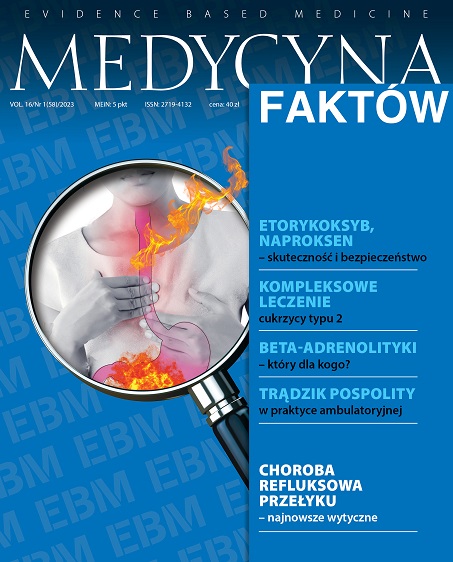Patient profiles – β-blockers (nebivolol, bisoprolol, metoprolol, carvedilol) Case report
Main Article Content
Abstract
β-blockers are the backbone of the armamentarium during everyday practice in doctors dealing with cardiovascular disease. The effectiveness of these drugs in various indications and a favorable safety profile have resulted in the popularity of these drugs. We currently have data confirming the impact on the reduction of mortality in certain groups of patients connected with the use of certain molecules from this group. Over the past decades, β-blockers have been used very frequently. However, a number of trials aimed to determine the optimal patient profile for a specific β-blocker. However, it is worth bearing in mind that there are significant differences between individual representatives of this group of drugs, and the recommended therapy should be individualized each time. Currently, we have highly cardioselective drugs, thanks to which it is possible to limit the influence of these drugs beyond the cardiovascular system. The main representatives of the β-blockers that are most often prescribed to patients are bisoprolol, metoprolol, nebivolol and carvedilol.
Article Details
Copyright © by Medical Education. All rights reserved.
References
2. The Cardiac Insufficiency Bisoprolol Study II (CIBIS-II): a randomised trial. Lancet. 1999; 353(9146): 9-13.
3. Flather MD, Shibata MC, Coats AJ et al. Randomized trial to determine the effect of nebivolol on mortality and cardiovascular hospital admission in elderly patients with heart failure (SENIORS). Eur Heart J. 2005; 26(3): 215-25.
4. Hjalmarson A, Fagerberg B. MERIT-HF mortality and morbidity data. Bas ic Res Cardiol. 2000; 95(suppl 1): I98-103.
5. Packer M, Fowler MB, Roecker EB et al. Effect of carvedilol on the morbidity of patients with severe chronic heart failure: results of the carvedilol prospective randomized cumulative survival (COPERNICUS) study. Circulation. 2002; 106(17): 2194-9.
6. Gheorghiade M, Colucci WS, Swedberg K. Beta-blockers in chronic heart failure. Circulation. 2003; 107(12): 1570-5.
7. Chatterjee S, Biondi-Zoccai G, Abbate A et al. Benefits of β blockers in patients with heart failure and reduced ejection fraction: network meta- analysis. BMJ. 2013; 346: f55.
8. Knuuti J, Wijns W, Saraste A et al. 2019 ESC Guidelines for the diagnosis and management of chronic coronary syndromes. Eur Heart J. 2020; 41(3): 407-77.
9. Hindricks G, Potpara T, Dagres N et al. 2020 ESC Guidelines for the diagnosis and management of atrial fibrillation developed in collaboration with the European Association for Cardio-Thoracic Surgery (EACTS). Eur Heart J. 2021; 42(5): 373-498.
10. Olshansky B, Rosenfeld LE, Warner AL et al. The Atrial Fibrillation Follow-up Investigation of Rhythm Management (AFFIRM) study: approaches to control rate in atrial fibrillation. J Am Coll Cardiol. 2004; 43(7): 1201-8.
11. Williams B, Mancia G, Spiering W et al. 2018 ESC/ESH Guidelines for the management of arterial hypertension. Eur Heart J. 2018; 39(33): 3021-104.
12. Tykarski A, Filipiak KJ, Januszewicz A et al. Zasady postępowania w nadciśnieniu tętniczym – 2019 rok. Nadciśnienie Tętnicze w Praktyce. 2019; 5(1): 1-86.
13. McDonagh TA, Metra M, Adamo M et al. 2021 ESC Guidelines for the diagnosis and treatment of acute and chronic heart failure. Eur Heart J. 2021; 42(36): 3599-726.

